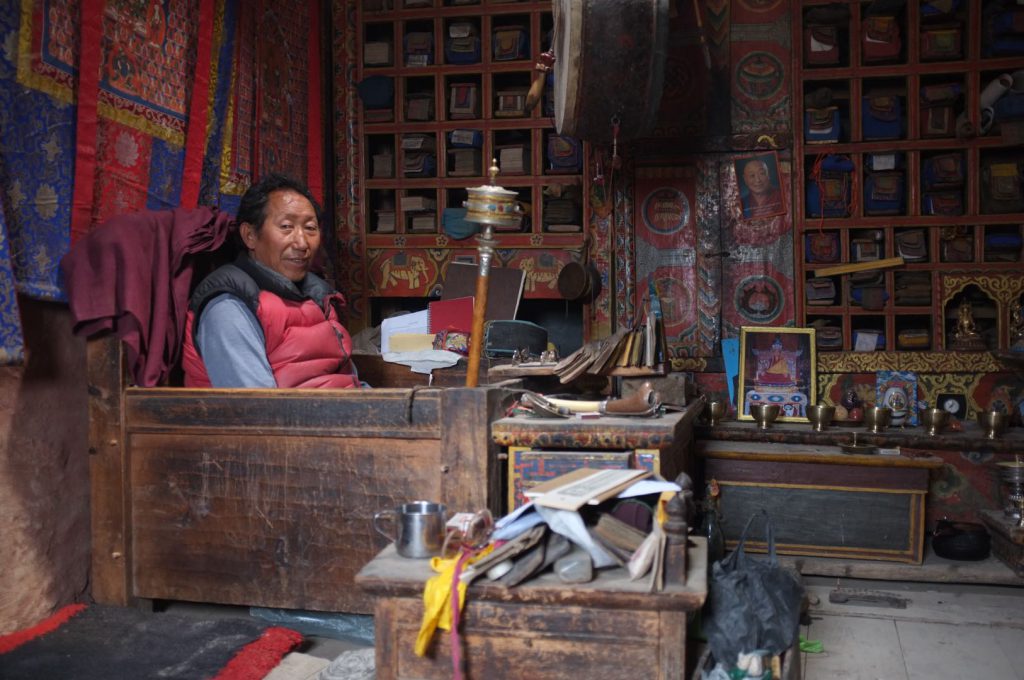
Lama Sherab Tenzin Rinpocze urodził się w 1953 w Nepalu. Dorastał w rodzinie praktykujących dzogczen, która należy do szanowanej linii Yangton. Przez wiele wieków – od czasu pierwszego króla Tybetu – najwyższe nauki Bonu (Dzogczen Sziang Sziung Njin Dziu) przekazywane były w tej linii rodowej. W XI-XII w. część tej rodziny przeniosła się do Mustangu i regionu Dolpo (obecnie Nepal), gdzie zbudowali kilka większych klasztorów. Klasztor Samling jest jednym z największych i najważniejszych klasztorów założonych przez Yangtona Gyaltsena Rinchena w XIII w. Od tego czasu przedstawiciele rodziny odgrywają znaczącą rolę w edukacji nauczycieli buddyjskich w tej części nepalskich Himalajów. Obecnie to właśnie Sherab Tenzin Rinpocze jest głównym lamą klasztoru Samling.
W wieku pięciu lat Rinpocze opanował grę na instrumentach muzycznych oraz nauczył się pisać i czytać po tybetańsku. W wieku jedenastu lat rozpoczął podstawowe studia tybetańskiej medycyny, będąc pod przewodnictwem jednego z najbardziej szanowanych lekarzy i zarazem jego dziadka – Namgyal Wangdu Rinpocze. Już w wieku 15 lat Rinpocze udzielał usług medycznych. Obecnie jest znany i szanowany w Himalajach, zarówno jako wielki nauczyciel duchowy, jak i lekarz specjalizujący się w tybetańskiej medycynie.
Rinpocze odbył wiele pielgrzymek do klasztorów Menri oraz Triten Norbutse w Indiach i Nepalu, gdzie otrzymał nauki od J.Ś. 33. Menri Trizina Rinpocze oraz J.E. Jongdzina Lopona Tenzina Namdaka Rinpocze. Wśród innych nauczycieli Sherab Tenzina Rinpocze znajduje się także Tsewang Lhacziap Rinpocze z klasztoru Samling.
Klasztor Samling i Sherab Tenzin Rinpocze odegrali istotną rolę w zachowaniu tradycji Yungdrung Bon w czasie Rewolucji Kulturalnej. Rinpocze pomagał zakładać klasztory w Indiach i Nepalu. Wiele testów należących do Kangjuru i Tengjuru (nauk Tonpy Szenraba i komentarzy mistrzów), czyli kanonu nauk tradycji Yungdrung Bon, zostało skopiowane ze starożytnych tekstów przechowywanych w klasztorze Samling.
Sherab Tenzin Rinpocze jest dzierżycielem wielu linii nauk, takich jak Dzogchen Martri Duknga Rangdrol, Rigpa Chertong, praktyki Cie (Khandro Sangcie), a także tradycji rytuału Walchu (gniewnej wody), która wymaga dużej realizacji praktyki jidama Walchen Gekho. Rinpocze jest także specjalistą w innych praktykach jidamów tradycji Yungdrung Bon, takich jak Zhang Zhung Meri, Walse, Takla Mebar i Garuda.
Klasztor Samling jest także ważnym centrum studiów i praktyki Bon Sarma, nowej tradycji Bon, która wywodzi się od Drenpa Namkhi (VIII wiek) i łączy elementy tradycji Bon i Njingma.
Lama Sherab spędził ponad 30 lata na indywidualnych odosobnieniach w klasztorze Samling, co sprawia, że ma duże doświadczenie i wiedzę we wszystkich praktykach i medytacjach przekazywanych w tym klasztorze.
Jako wielki praktykujący Lama Sherab ma wyjątkową wiedzę i doświadczenie w wielu różnych rytuałach: uzdrawiających, długiego życia, bogactwa, pomyślności, oczyszczających przeszkody życiowe i medytacyjne, usuwających negatywne wpływy, itd.
English
Lama Tenzin Sherab Rinpoche was born in 1953. He was born to the Yangton family, a spiritual lineage famous in Tibet as great and historically influential practitioners. The highest teachings of Bon Dzogchen – Shang Shung Nyengyud over hundreds of centuries passed directly with the family – starting with the first king of Tibet. In the 11th-12th centuries, some branches of the family moved to Mustang and Dolpo region and built several large monasteries in the Himalayas. Samling Monastery is one of the largest and most important, founded by Yangton Gyaltsen Rinchen in the 13th century. Since then, representatives of the family lineage are responsible for educating Lamas in this part of Nepalese Himalaya. Currently, Sherab Tenzin Rinpoche is the head Lama of Samling monastery.
At the age of five Lama Sherab Rinpoche learned to play religious instruments and learned to read and write in Tibetan. At the age of eleven Rinpoche began foundational studies of traditional Tibetan medicine with guidance of one of the most respected doctors – his grandfather Namgyal Wangdu Rinpoche. When he was fifteen years old, he began to receive patients and provide medical services. Rinpoche is widely known and respected in the Himalayas as a great spiritual leader and a physician specializing in Tibetan medicine
During several pilgrimages to Menri and Triten Norbutse monasteries located in India and Nepal, respectively, Lama Sherab received teachings from H.H. The 33rd Menri Tridzin Rinpoche and H.E. Yongdzin Lopon Tenzin Namdak Rinpoche. Sherab Tenzin Rinpoche had also many other teachers, including i.a. Tsewang Lhakyab Rinpoche from Samling.
Samling Monastery and Sherab Tenzin Rinpoche personally played a vital part in preserving Yungdrung Bon after near extinction during the Cultural Revolution in China. He was instrumental in helping the main monastic centres set roots in India and Nepal. A very significant part of modern Kangyur and Tengyur, which are Words of Tonpa Shenrab Miwoche and Explications and teachings by saints and realized yogi respectively, together constituting the main scripture of Yungdrung Bon spiritual tradition, were copied from original ancient texts secretly preserved at Samling Monastery.
Outside of Tibet, Sherab Tenzin Rinpoche personally is the main lineage holder of such important spiritual teachings as Great Perfection teachings of Dzogchen Mar Tri Duknga Rangdrol and Dzogchen Rigpa Cher Tong, chod practices of Khandro Sang Chod, living tradition of Walchu ritual (wrathful waters) requiring deep practical realization of yidam Walchen Gekho, as well as other outer and inner yidams and practices more commonly practiced in Yungdrung Bon, such as Zhang Zhung Meri, Walse, Tagla Mebar, Garuda and few other practices.
In addition to that, Samling Monastery is also an important centre for study and practice of Bon Sarma, tradition of New Bon originating from Drenpa Namkha, such as Yab-Se, bringing spiritual lineages of Bon and Nyingma closer together.
As a yogi, Lama Sherab has over 30 years of personal practice in seclusion at Samling, which give him practical experiential knowledge of all the lineages and methods of spiritual practice preserved at the monastery.
As a great tantric practitioner, Lama Sherab is exceptionally knowledgeable in a multitude of rituals and rites for health and longevity, wealth, luck, purifying of all kinds of obstacles in ordinary life and in spiritual practice, expelling negative influences, etc.
